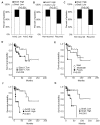AXIN2 and SNAIL expression predict the risk of recurrence in cutaneous squamous cell carcinoma after Mohs micrographic surgery
- PMID: 32194711
- PMCID: PMC7039156
- DOI: 10.3892/ol.2020.11324
AXIN2 and SNAIL expression predict the risk of recurrence in cutaneous squamous cell carcinoma after Mohs micrographic surgery
Abstract
Recurrence is a common complication observed during cutaneous squamous cell carcinoma (cSCC) treatment; however, biomarkers for predicting recurrence in cSCC remain unknown. The present study aimed to investigate the predictive value of axis inhibition protein 2 (AXIN2) and SNAIL expression in cSCC recurrence. AXIN2 and SNAIL expression was evaluated using immunohistochemistry in 111 cSCC tissue samples obtained from 18 patients who presented recurrence (recurrence interval, 1-91 months) and 93 patients who did not experience recurrence following Mohs micrographic surgery (MMS) during the follow-up period (156 months). Nomogram construction was performed using patients' clinicopathological characteristics and AXIN2 and SNAIL protein expression. The results demonstrated that high AXIN2 (histoscore >100) and SNAIL (histoscore >100) expression was detected in 35 and 44 cSCC tissues, respectively. Furthermore, the expression levels of AXIN2 and SNAIL were significantly associated in patients with cSCC (P=0.001). AXIN2 and SNAIL expression levels were significantly associated with tumor size (P=0.021 and P=0.044, respectively) and recurrence of cSCC (P=0.017 and P=0.042, respectively). In addition, the results of the Kaplan-Meier curve analysis revealed that recurrence-free survival was significantly associated with tumor size (P=0.025), differentiation status (P<0.001), AXIN2 expression (P=0.001) and SNAIL expression (P=0.001). Furthermore, the results of the multivariate analysis demonstrated that age (P=0.043), AXIN2 expression (P=0.001) and SNAIL expression (P=0.045) were independent risk factors for cSCC recurrence in the present cohort. A nomogram for predicting the 1-, 2-, 3-, and 5-year recurrence-free survival was developed for patients with cSCC by including independent risk factors with a concordance index of 0.75. The results suggested that high AXIN2 and SNAIL expression may be considered as potential risk factors for cSCC recurrence. This nomogram may therefore be useful to assess the probability of recurrence in patients with cSCC following MMS.
Keywords: SNAIL; axis inhibition protein 2; cutaneous squamous cell carcinoma patients; mohs micrographic surgery; predictive nomogram; recurrence.
Copyright: © Zhao et al.
Figures




Similar articles
-
Risk Factors of Microscopically Tumor-Free Surgical Margins for Recurrence and Survival of Oral Squamous Cell Carcinoma Patients.Front Oncol. 2022 Jul 7;12:930988. doi: 10.3389/fonc.2022.930988. eCollection 2022. Front Oncol. 2022. PMID: 35875099 Free PMC article.
-
A nomogram combining clinical factors and biomarkers for predicting the recurrence of high-risk cutaneous squamous cell carcinoma.BMC Cancer. 2022 Nov 3;22(1):1126. doi: 10.1186/s12885-022-10213-2. BMC Cancer. 2022. PMID: 36324094 Free PMC article.
-
Snail and Axin2 expression predict the malignant transformation of oral leukoplakia.Oral Oncol. 2017 Oct;73:48-55. doi: 10.1016/j.oraloncology.2017.08.004. Epub 2017 Aug 12. Oral Oncol. 2017. PMID: 28939076
-
Mohs Micrographic Surgery for Cutaneous Squamous Cell Carcinoma.Cancers (Basel). 2024 Jun 28;16(13):2394. doi: 10.3390/cancers16132394. Cancers (Basel). 2024. PMID: 39001454 Free PMC article. Review.
-
Consensus for Nonmelanoma Skin Cancer Treatment, Part II: Squamous Cell Carcinoma, Including a Cost Analysis of Treatment Methods.Dermatol Surg. 2015 Nov;41(11):1214-40. doi: 10.1097/DSS.0000000000000478. Dermatol Surg. 2015. PMID: 26445288 Review.
Cited by
-
Risk Factors of Microscopically Tumor-Free Surgical Margins for Recurrence and Survival of Oral Squamous Cell Carcinoma Patients.Front Oncol. 2022 Jul 7;12:930988. doi: 10.3389/fonc.2022.930988. eCollection 2022. Front Oncol. 2022. PMID: 35875099 Free PMC article.
-
MicroRNA-21 Contributes to Cutaneous Squamous Cell Carcinoma Progression via Mediating TIMP3/PI3K/AKT Signaling Axis.Int J Gen Med. 2021 Jan 8;14:27-39. doi: 10.2147/IJGM.S275016. eCollection 2021. Int J Gen Med. 2021. Retraction in: Int J Gen Med. 2023 Nov 07;16:5159-5160. doi: 10.2147/IJGM.S448411. PMID: 33447074 Free PMC article. Retracted.
-
Role of immunohistochemistry in the diagnosis and staging of cutaneous squamous-cell carcinomas (Review).Exp Ther Med. 2022 Jun;23(6):383. doi: 10.3892/etm.2022.11308. Epub 2022 Apr 11. Exp Ther Med. 2022. PMID: 35495612 Free PMC article. Review.
-
Wnt signaling in cancer: from biomarkers to targeted therapies and clinical translation.Mol Cancer. 2025 Apr 2;24(1):107. doi: 10.1186/s12943-025-02306-w. Mol Cancer. 2025. PMID: 40170063 Free PMC article. Review.
-
A nomogram combining clinical factors and biomarkers for predicting the recurrence of high-risk cutaneous squamous cell carcinoma.BMC Cancer. 2022 Nov 3;22(1):1126. doi: 10.1186/s12885-022-10213-2. BMC Cancer. 2022. PMID: 36324094 Free PMC article.
References
LinkOut - more resources
Full Text Sources
Research Materials
